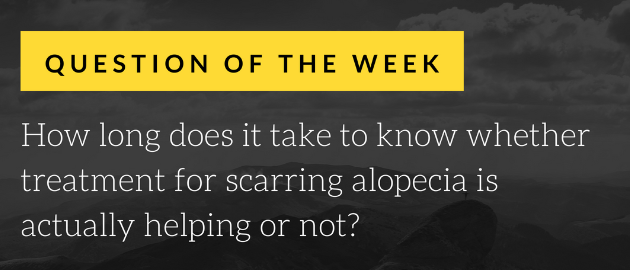How long does it take to know if scarring alopecia treatments are working?T
QUESTION
QUESTION: I was diagnosed with lichen planopilaris. My dermatologist put me on topical steroids (betamethasone diproprionate) and doxycycline (100 mg daily). How long does this treatment take before I know if I am benefiting?
ANSWER
Thanks for the question. The real answer depends on a few factors as you'll see below. It could be as early as a few days before your get a sense if you are on track or several months. Let me explain.
As you've probably come to know from your own physicians, lichen planopilaris (LPP) is a type of scarring alopecia that causes permanent hair loss. We don't typically expect to see hair regrowth to any significant degree (unless treatment is undertaken in the very earliest of stages). The goal of treatment is to stop the disease and prevent it from getting any worse.
Lichen planopilaris (LPP) is often 'symptomatic', meaning that many patients have itching, burning or pain/tenderness and notice increased amounts of daily shedding. Some have all four of these of these symptoms and some have two or three. Of course, about one-third or so of patients don't really have much in the way of symptoms and the scalp feels pretty normal to them. They may just notice a bit of increased shedding.
The reason this concept is important to mention is because patients who do experience scalp symptoms with their LPP will know if a matter of a few days if they are benefiting from topical steroid treatments. Strong steroids like betmethasone dipropionate usually act to relieve symptoms very quickly and can help reduce shedding quite quickly as well. Oral immunomodulating medications like doxycycline take a bit long but also act within a few weeks. So, if a patient with LPP has considerable itching, burning and tenderness and finds that that the betamethasone is helping to relieve symptoms and shedding after a few days - this means the treatment is benefiting.
Now for a bit more involved discussion.
Difference between short term vs long term benefits
The "first step" for a patient with LPP who is symptomatic is to reduce their scalp symptoms and shedding. This is what we are watching for. This is what we are hoping for. If a patient has itching that they rate as 7 out of 10, we hope in future apportionments that it reduces to 1 out of 10 or maybe even 0 out of 10. If they feel they once were losing 100 hairs daily and now feel it's under 50 hairs per day... this too is a good sign.
What we don't know early on in the course of treatment is whether the reduction in symptoms actually correlates with a cessation of hair loss. In other words, a reduction in symptoms is terrific, but it's really the ability to prove that the hair loss is slowing down or stopping that is the most important thing. This comes with scalp examination and photography.
Scalp examination and photography prove a treatment is benefiting
If a patient states that his or her itching is greatly improved, but a photograph at the 4-6 month follow up appointment shows that more hair loss has occurred, this means that the treatment is not working at all or not working well enough. If the treatment is not working at all, it needs to be stopped and another treatment started. If the treatment is not working well enough but is still helping to slow the rate of loss down a bit, one might consider continuing that treatment (as it is doing something) and adding a second treatment. Of course, this is a professional judgement, and something we stop treatments that are are only working a bit and bring on board treatments that have potential to stop the disease completely.
Generally speaking if treatments are not working, a photograph will show more and more loss every 4-6 months. Some patients have very slowly progressing LPP and it will take 1 year to show that further hair loss is occurring. Nevertheless, carefully documented photographs will show whether the disease is progressing or stopping. The importance of photography can't be overemphasized.
Up close examination of the scalp will also provide helpful signs for patients with LPP and so frequent examination by a dermatologist is important. The presence of redness and scaling in the scalp are all potential signs of disease activity. If the amount of redness or scale improves with treatment, this usually means the treatment is working. While the up close examination is important to judge whether a disease is active or not - the most important of all is the photograph of the scalp.
Summary
Thanks again for the great question. I hope this clarifies things. The real answer is that a patient will truly know in several months if the treatment is truly working by comparing photographs. There are some really helpful things to observe for in the first few weeks and months to give us hints that things are working. This includes a decrease in symptoms and shedding and a decrease in redness and scaling. The most valuable of all is the photograph.

